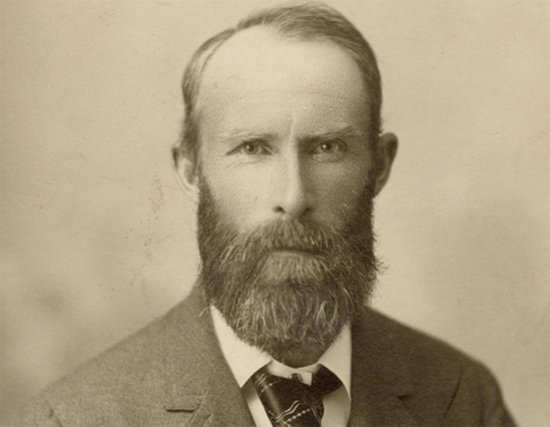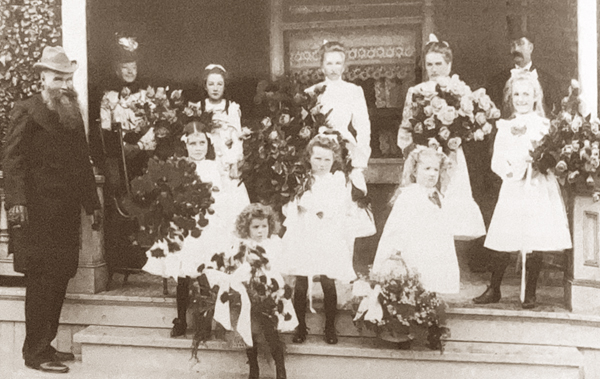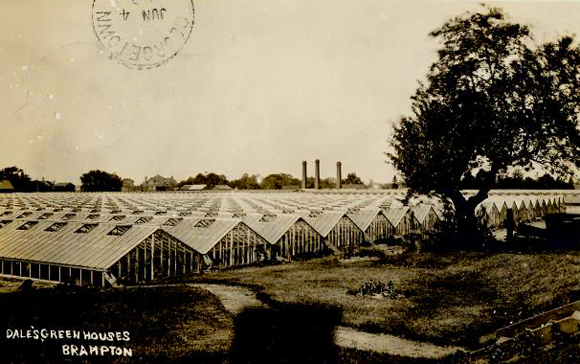
The Flowertown of Canada
Many readers of the BTA newsletter will know that Brampton was once known as the “Flowertown” of Canada. The reputation related chiefly, but not entirely, to the Dale Estate, one of the world’s largest growers of flowers “under glass” and for many years Brampton’s largest employer.
The business began with the arrival in Brampton in 1863 of Edward Dale. From a parcel of land at Hurontario and Vodden—about a kilometre from the downtown four corners area—Edward Dale built his first greenhouse, a twelve-foot by twenty-foot dugout covered in clay and sod and kept warm by a flue furnace. By the late 1860s, Edward had created a thriving year-round vegetable-selling business.

Edward’s eldest son, Harry, joined the business, becoming a partner in 1874. Harry’s passion was the growing of flowers, particularly roses. Flowers were added to the business’s greenhouse production. Before long, the quantity and profitability of flowers exceeded those of vegetables.
Harry was very particular about roses. His objective was to grow the world’s sturdiest, longest-lasting roses with the richest colours, the most uniform size and the softest petals. With those standards, Dale roses, winners of many world competitions, began to be shipped throughout North America, England and Europe.
By the time Edward retired in 1882, the business had two stand-alone greenhouses. By 1903, it had twenty-one. By the summer of 1911, it had twenty acres under glass, producing ten million blooms a year, making it the third largest greenhouse operation in the world.
While Harry’s brothers Tom, Ned and Will, were involved in the family business, on their father’s retirement it was Harry whose name the business took and who continued as its directing mind. His untimely death in 1900 had a chilling effect on Brampton. At that time, almost twenty-five percent of the town’s population was employed by the Dale company, directly or in some other peripheral manner. But the enterprise continued, its management assumed by Harry’s executors, which included his business manager, T.W. (Tommy) Duggan. In 1921, the Dale Estate was incorporated. Its board of directors was comprised of four of Harry’s daughters, Sarah, Bertha, Ethel and Kate.
The Dale Estate was synonymous with Brampton. Its stylized red rose with the Dale name punched into its dark green leaf was present on workbooks (or “scribblers”) of Brampton students. Brampton residents could tell the hour of day based on the Dale whistle sounded to alert its workers to the changing shifts. Dignitaries from across the continent travelled to Brampton to view the Dale greenhouses. Every Bramptonian acquired cast off flowers—those that did not meet the exacting Dale standards—from the Dale “dump pile.” Eight hundred Dale roses were shipped to Ottawa and Montreal for the funeral of Canada’s first prime minister, Sir John A. Macdonald.

As mentioned, the Dales were not the only florists in Brampton. In 1893, William Fendley, who specialized in the growing of violets and carnations, began selling flowers in Brampton. Two generations of Fendley flower growers followed him.
Edwin Calvert began his flower growing business in Brampton in the first decade of the twentieth century. By 1953, he was the largest grower of chrysanthemums and bulb stock in Canada, operating 450,000 square feet of greenhouses.
Gus Lagerquist operated greenhouses in Brampton between 1919 and 1970. He had 60,000 square feet of greenhouses in the 1970s, when his business closed.
Richard Jennings, an early successful grower, donated his land for athletic purposes. It became Rosalie Jennings Park, the home of the Brampton Excelsiors Lacrosse and many other Brampton sports teams. It is now the location of the YMCA on Union Street.
The presence of these growers and others earned Brampton the designation of the Flowertown of Canada, or a little later, the Flower City.
Like all good things, the business of the Dale Estate eventually came to an end. Rising fuel costs and a decrease in the market for flowers in the 1960s and 1970s took their toll on the once so successful enterprise. A merger with the Calvert business did not staunch the decline. The company was closed in 1980.

Today the Flowertown legacy of Brampton is dwindling but there are subtle reminders of its once great influence. The large 800-plus seat theatre built in downtown Brampton is aptly named the Rose Theatre. The city places great emphasis on the flowers planted in our parks and on public street facing green spaces. Check them out next Spring. They really are lovely. Recently a plaque was erected by the Ontario Heritage Trust to memorialize the once great grower. Efforts are underway to create a more prominent monument.
Acknowledgements:
Text: Dale O’Hara, Acres of Glass, The Story of the Dale Estate and How Brampton Became “The Flower Town of Canada,” Eastendbooks, 2007.
Photos: The Region of Peel Archives


To Order Your Copies
of Lynne Golding's Beneath the Alders Series
